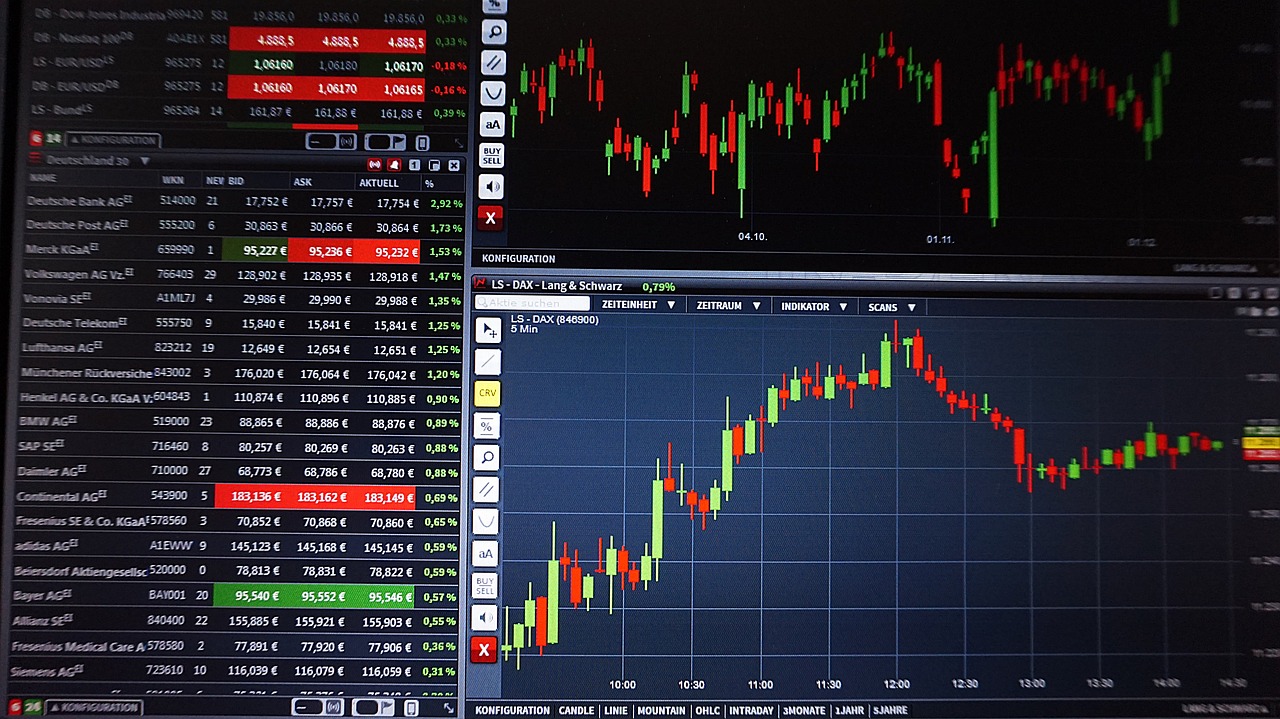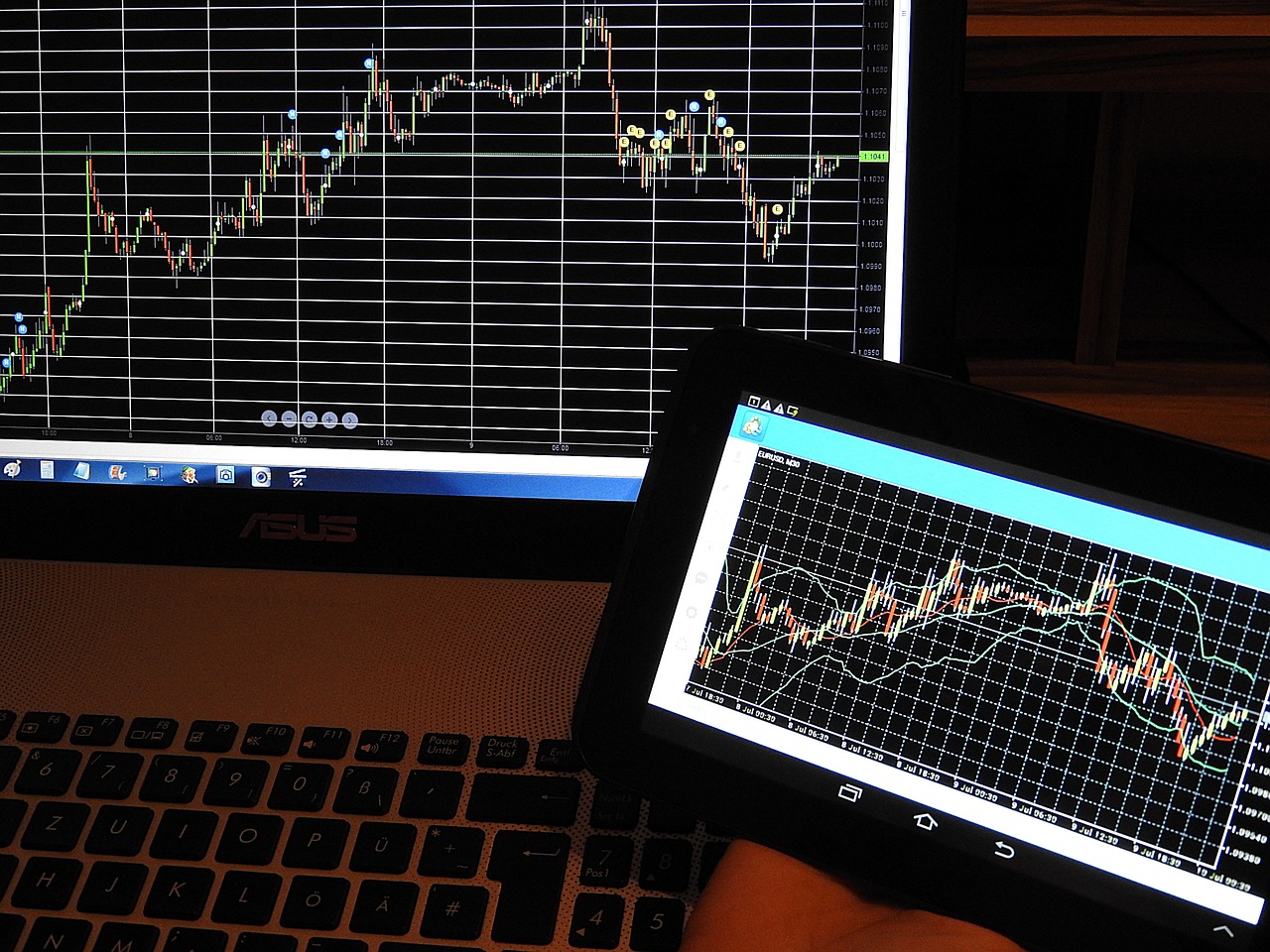Understanding the Use of Trend Analysis in Trading Strategies
In the dynamic world of trading, understanding market movements is crucial for success. Trend analysis serves as a powerful tool for traders, enabling them to decipher historical price movements and predict future behaviors. Imagine trying to navigate a ship through turbulent waters without a compass; that’s what trading can feel like without the guidance of trend analysis. It provides clarity amidst chaos, helping both novice and experienced traders make informed decisions. By identifying patterns and trends in price data, traders can develop effective strategies that align with market movements, ultimately leading to more profitable outcomes.
At its core, trend analysis involves examining past price data to identify consistent patterns. This method is not just about looking at the numbers; it's about understanding the story behind those numbers. Traders who grasp these fundamentals can anticipate future price behaviors, allowing them to capitalize on market opportunities. Whether you're a beginner testing the waters or a seasoned trader seeking to refine your approach, mastering trend analysis is essential.
The significance of trend analysis extends beyond just identifying price movements. It encompasses a variety of methodologies that can be tailored to suit individual trading styles. For instance, some traders may prefer a more technical approach, relying on charts and indicators, while others might focus on fundamental analysis, considering economic factors that influence market trends. Regardless of the method chosen, the ultimate goal remains the same: to make informed trading decisions that maximize profit potential.
As we dive deeper into the world of trend analysis, it’s important to recognize its advantages. One of the primary benefits is the ability to identify entry and exit points. By understanding where a trend is heading, traders can strategically buy low and sell high, increasing their chances of success. Furthermore, trend analysis can help traders manage risk effectively. By recognizing when a trend may be reversing or losing strength, traders can adjust their strategies accordingly to protect their investments.
In summary, trend analysis is a vital component of successful trading strategies. It empowers traders to understand market dynamics, make informed decisions, and ultimately improve their trading performance. As we explore the various types of trends and the tools available for analysis, keep in mind that the key to success lies in continuous learning and adaptation.
Trend analysis involves examining historical price movements to identify patterns. Understanding these fundamentals is crucial for traders aiming to predict future price behaviors and make informed trading decisions.
Trends can be classified into three main types: upward, downward, and sideways. Each trend type carries different implications for trading strategies and requires distinct approaches to capitalize on potential market movements.
An upward trend indicates increasing prices over time. Recognizing these trends early can help traders maximize profits by entering positions at favorable prices before the market peaks. Think of it like catching a wave; the earlier you spot it, the better your chances of riding it all the way to shore.
Common indicators used to identify upward trends include moving averages and trend lines. These tools assist traders in confirming the strength and sustainability of the trend. For example, when the price consistently stays above a moving average, it signals that the upward trend is strong and worth pursuing.
Effective strategies for upward trends often involve buying on dips and utilizing trailing stops to secure profits as the market rises, ensuring a balanced risk-reward ratio. It’s essential to remain vigilant and ready to adjust your strategy as the market evolves.
A downward trend signifies decreasing prices. Traders must learn to recognize these trends to minimize losses and identify potential short-selling opportunities in a bearish market. Just as one would prepare for a storm, recognizing a downward trend allows traders to brace for impact and protect their investments.
Technical indicators play a vital role in trend analysis. They provide traders with quantifiable data to support their decisions, enhancing the overall effectiveness of their trading strategies.
Moving averages smooth out price data to identify trends more clearly. Traders often use them to determine entry and exit points based on the direction of the moving average. It’s like having a pair of glasses that helps you see the market more clearly.
The RSI is a momentum oscillator that measures the speed and change of price movements. It helps traders identify overbought or oversold conditions, indicating potential trend reversals. By keeping an eye on the RSI, traders can avoid getting caught in a market that’s about to turn.
Integrating trend analysis with other trading strategies, such as fundamental analysis or risk management techniques, can enhance decision-making and improve overall trading performance. This multi-faceted approach is akin to having a toolkit; the more tools you have, the better equipped you are to handle various market conditions.
Incorporating risk management techniques alongside trend analysis helps traders protect their capital. Strategies such as setting stop-loss orders can mitigate losses during unfavorable market movements. Think of it as wearing a seatbelt while driving; it’s a precaution that can save you from significant setbacks.
Understanding fundamental factors that influence market trends can provide traders with a comprehensive view, aiding in more informed decision-making and enhancing the effectiveness of trend analysis. By blending these approaches, traders can navigate the complexities of the market with greater confidence.
- What is trend analysis? Trend analysis is the practice of examining historical price movements to identify patterns that can help predict future price behaviors.
- Why is trend analysis important in trading? It allows traders to make informed decisions, identify entry and exit points, and manage risk effectively.
- What are the types of trends? The three main types of trends are upward, downward, and sideways trends.
- How can I identify upward trends? By using indicators like moving averages and trend lines, traders can recognize upward trends early to maximize profits.
- What role do technical indicators play in trend analysis? Technical indicators provide quantifiable data that supports trading decisions, enhancing the effectiveness of strategies.

The Basics of Trend Analysis
Trend analysis is a powerful tool in the trading world, acting like a compass that guides traders through the often turbulent seas of financial markets. At its core, trend analysis involves examining historical price movements to identify patterns that can help predict future price behaviors. Think of it as looking at the footprints in the sand to determine which direction the tide might take next. By understanding these fundamentals, traders—whether novices or seasoned professionals—can make informed decisions that could significantly impact their trading success.
To truly grasp the essence of trend analysis, it's essential to recognize the different phases of market movement. Prices don’t just move randomly; they exhibit patterns over time. These patterns can be categorized into three main types: upward trends, downward trends, and sideways trends. Each type carries its own implications for trading strategies, requiring different approaches to capitalize on potential market movements.
When traders analyze trends, they often rely on various methodologies and tools to enhance their understanding. For instance, they might utilize charts to visualize price movements or employ statistical methods to quantify trends. The ultimate goal is to identify a trend's strength and sustainability. This is where the concept of support and resistance levels comes into play. Support levels indicate where prices tend to stop falling and bounce back, while resistance levels show where prices tend to stop rising and drop back. By pinpointing these levels, traders can make more educated guesses about when to enter or exit trades.
Moreover, it’s important to understand that trends can last for varying durations. Some trends are short-lived, akin to a fleeting summer storm, while others can persist for months or even years, much like a steady, unyielding river. This is why traders often categorize trends into three time frames: short-term, medium-term, and long-term. Each time frame requires different strategies and risk management techniques, making it crucial for traders to adapt their approaches based on the trend's duration.
In summary, mastering the basics of trend analysis is like learning the rules of a game before you play. It sets the foundation for developing effective trading strategies, enabling traders to navigate the market with confidence. As we delve deeper into the world of trend analysis, we will explore the different types of trends and how to identify them effectively, ensuring you have the tools necessary to thrive in the dynamic trading environment.
- What is trend analysis?
Trend analysis is the practice of evaluating historical price movements to identify patterns and predict future price behavior in the financial markets. - Why is trend analysis important for traders?
It helps traders make informed decisions, maximize profits, and minimize losses by understanding market movements and potential price changes. - What are the main types of trends?
The three main types of trends are upward trends, downward trends, and sideways trends, each requiring different trading strategies. - How can I identify trends?
Trends can be identified using various tools such as moving averages, trend lines, and support and resistance levels.

Types of Trends in Trading
When diving into the world of trading, understanding the types of trends is essential for making informed decisions. Trends can be broadly categorized into three main types: upward, downward, and sideways. Each of these trends represents a different market sentiment and requires distinct strategies to capitalize on potential movements. Think of trends as the underlying currents of a river; they guide your boat, or in this case, your trading decisions, towards the right direction.
Let’s break down these trends a bit further:
| Trend Type | Description | Implications for Traders |
|---|---|---|
| Upward Trend | Characterized by rising prices over time. | Opportunity to buy low and sell high, maximizing profits. |
| Downward Trend | Defined by falling prices, indicating a bearish market. | Potential for short-selling and minimizing losses. |
| Sideways Trend | Prices move within a horizontal range, showing indecision. | Traders may look for breakout opportunities or range-bound strategies. |
Each trend type carries its own set of implications for traders. For instance, when you spot an upward trend, it’s like catching a wave; you want to ride it as long as possible. On the flip side, a downward trend can feel like a sinking ship, where recognizing the signs early can help you jump off before it’s too late. Meanwhile, a sideways trend might leave you feeling a bit stuck, as prices oscillate without a clear direction. In these situations, patience and strategy become your best friends.
Understanding these trends is not just about recognizing patterns; it’s about developing a strategic mindset that allows you to adapt to changing market conditions. By identifying the type of trend currently prevailing in the market, traders can tailor their strategies effectively. For example, in an upward trend, traders might focus on buying on dips, while in a downward trend, they may consider short-selling opportunities. The key is to remain flexible and responsive to the market's movements.
In conclusion, mastering the types of trends in trading is like learning the language of the market. It equips you with the tools to navigate through the complexities of trading, ensuring that you’re not just another face in the crowd but a savvy trader who knows when to act and when to hold back. So, whether you’re a novice or a seasoned trader, grasping these trends can significantly enhance your trading strategies and results.
- What is the importance of identifying trends in trading? Identifying trends helps traders make informed decisions about when to enter or exit the market, maximizing potential profits and minimizing losses.
- Can trends change quickly? Yes, market conditions can change rapidly, so it’s crucial for traders to stay updated and be ready to adjust their strategies accordingly.
- How can I practice trend analysis? You can practice trend analysis by using historical price charts and applying various indicators to identify patterns and trends over time.

Identifying Upward Trends
Identifying an upward trend in trading is like spotting a rising sun on the horizon; it signals opportunities and potential profits. An upward trend is characterized by a series of higher highs and higher lows in price movements, indicating that buyers are in control and pushing prices upwards. For traders, recognizing these trends early is crucial because it allows them to enter positions at advantageous prices before the market reaches its peak. But how can you effectively identify these upward trends? Let's break it down.
First and foremost, traders often rely on visual tools such as trend lines and moving averages. A trend line is drawn by connecting the lows of price movements in an upward direction. If the price consistently bounces off this line, it confirms the strength of the upward trend. Meanwhile, moving averages, which smooth out price data, help traders see the overall direction of the market. For instance, if a shorter-term moving average crosses above a longer-term moving average, it’s often a bullish signal that an upward trend may be in play.
Additionally, traders should watch for certain key indicators that suggest an upward trend is forming or strengthening. Here are some of the most common indicators:
- Higher Highs and Higher Lows: This pattern is the foundation of an upward trend, where each peak is higher than the last.
- Volume Increase: An increase in trading volume during upward price movements can indicate strong buyer interest and validate the trend.
- Momentum Indicators: Tools like the Relative Strength Index (RSI) can help confirm that the trend is gaining momentum.
Recognizing these signs early can lead to significant advantages in the market. Imagine you’re at a concert and you hear the crowd cheering louder; you know something exciting is about to happen. Similarly, when you see these indicators aligning, it’s a cue that you might want to take action before the trend peaks. Always remember, the earlier you spot an upward trend, the better positioned you are to capitalize on it.
In conclusion, identifying upward trends is essential for any trader looking to maximize their profits. By utilizing tools like trend lines and moving averages, and by keeping an eye on key indicators, traders can position themselves advantageously in the market. So, the next time you’re analyzing price movements, ask yourself: Are we witnessing the dawn of a new upward trend?

Indicators of Upward Trends
When it comes to identifying upward trends in trading, several key indicators can help traders pinpoint the right moments to enter the market. Recognizing these indicators is like having a treasure map; they guide you through the complex landscape of market movements, leading you to potential profits. Two of the most commonly used tools in this quest are moving averages and trend lines.
Moving averages are particularly useful because they smooth out price data, allowing traders to see the general direction of the trend more clearly. Imagine trying to navigate through a foggy night—you need a clear signal to guide your way. Moving averages act as that beacon, helping traders determine whether the market is trending upwards or downwards. There are different types of moving averages, such as the simple moving average (SMA) and the exponential moving average (EMA), each serving its purpose. The SMA calculates the average of a set number of prices over a specific period, while the EMA gives more weight to recent prices, making it more responsive to new information.
Another essential tool is the trend line, which traders draw on price charts to connect the lows of an upward trend. This line acts as a visual representation of support, indicating where prices are likely to bounce back up if they dip. By analyzing the angle and steepness of the trend line, traders can gauge the strength of the upward trend. A steeper angle may suggest a stronger trend, while a flatter line could indicate a potential reversal or weakening momentum.
Moreover, traders often combine these indicators with other analytical tools to create a more robust trading strategy. For instance, they might look at the volume of trades accompanying an upward trend. A rising price accompanied by increasing volume can signal strong buying interest, reinforcing the validity of the upward trend. Conversely, if prices rise but volume decreases, it might raise a red flag, suggesting that the trend could be losing strength.
In summary, identifying upward trends requires a keen eye and the right tools. By utilizing moving averages, trend lines, and volume analysis, traders can make informed decisions that maximize their profit potential. The ability to recognize these indicators can transform a novice trader into a savvy market participant, ready to seize opportunities as they arise.
- What is the most reliable indicator for identifying upward trends?
While no single indicator is foolproof, moving averages and trend lines are among the most reliable for spotting upward trends. - How can I combine indicators for better results?
Using multiple indicators, such as moving averages alongside volume analysis, can provide a more comprehensive view of market conditions. - Is it necessary to use technical indicators?
While technical indicators can enhance your trading strategy, understanding market fundamentals is equally important for making informed decisions.

Trading Strategies for Upward Trends
When it comes to trading in an upward trend, the key is to harness the momentum of rising prices to your advantage. This means not just recognizing that the market is on an upward trajectory, but also knowing how to position yourself strategically within that movement. One effective approach is to buy on dips. This strategy involves purchasing assets when their prices temporarily decline during an overall upward trend. Think of it as waiting for the perfect wave to surf; you want to catch it at just the right moment to ride it all the way to the shore.
Another important strategy is the use of trailing stops. A trailing stop is a dynamic stop-loss order that adjusts as the price of the asset rises. This method allows you to secure your profits while still giving your trade room to grow. Imagine you’re climbing a mountain; you want to set up safety nets below you as you ascend, so if you slip, you don’t fall all the way back down. Trailing stops act as those safety nets, ensuring that you lock in gains without prematurely exiting a profitable position.
Additionally, it’s crucial to analyze the volume accompanying the price movements. Rising prices should ideally be accompanied by increasing volume, which indicates strong buying interest. If you notice that prices are climbing but the volume is declining, it might be a red flag that the upward trend is losing steam. In such cases, it’s wise to exercise caution and reassess your positions.
Moreover, traders can utilize technical indicators to fine-tune their strategies. For instance, the Moving Average Convergence Divergence (MACD) is a popular tool that helps traders identify potential buy signals in an upward trend. When the MACD line crosses above the signal line, it can indicate a good entry point. Similarly, the Bollinger Bands can help traders understand whether the price is overextended or if there’s still room to grow. By integrating these indicators into your trading strategy, you can make more informed decisions.
Lastly, it’s important to maintain a balanced risk-reward ratio. This means assessing how much you are willing to risk on a trade compared to the potential reward. A common guideline is to aim for a minimum of a 1:2 ratio, which means for every dollar you risk, you should aim to make at least two dollars. This disciplined approach can help you navigate the ups and downs of the market while keeping your trading account healthy.
- What is the best time frame for trading upward trends?
It depends on your trading style. Day traders might focus on shorter time frames, while swing traders may look at daily or weekly charts.
- How do I know when an upward trend is reversing?
Look for signs like lower highs and lower lows on the price chart, or bearish divergence in momentum indicators.
- Can I trade upward trends without technical analysis?
While it’s possible, using technical analysis enhances your ability to make informed decisions and increases your chances of success.

Identifying Downward Trends
Identifying downward trends is an essential skill for traders who want to navigate the often turbulent waters of the financial markets. A downward trend signifies that prices are consistently decreasing over time, which can be a red flag for traders who are not prepared. Imagine walking into a store where everything is on sale, but instead of prices going up, they keep dropping. That’s the essence of a downward trend—prices are in a constant state of decline, and understanding this can be your ticket to minimizing losses or even capitalizing on short-selling opportunities.
Recognizing a downward trend can sometimes feel like spotting a rare bird in the wild; it requires keen observation and a bit of practice. Traders typically look for specific indicators that signal a downward trend. These may include a series of lower highs and lower lows on a price chart, which visually depict the market's bearish sentiment. When you see these patterns, it’s like a warning sign flashing in front of you, alerting you to the potential risks ahead.
To effectively identify downward trends, traders often employ various tools and techniques. For instance, moving averages can be particularly useful. When the short-term moving average crosses below the long-term moving average, this crossover can serve as a clear indication that a downward trend is in motion. Additionally, the use of trend lines can help visualize the trend; by connecting the lower highs, traders can draw a line that illustrates the downward trajectory of the market.
Moreover, some traders look at volume trends, as increased selling volume can confirm the strength of a downward trend. If more people are selling than buying, it’s a strong indication that the market sentiment is leaning bearish. This can be especially crucial during market corrections or economic downturns, where understanding the underlying forces at play can make all the difference.
In summary, identifying downward trends is not just about spotting decreasing prices; it’s about understanding the broader market context. Traders who can accurately identify these trends and act accordingly can protect their investments and even profit from market declines. So, the next time you see a chart with a downward slope, don’t just see it as a loss; see it as an opportunity to refine your trading strategy and make informed decisions.
- What is a downward trend? A downward trend occurs when the price of an asset consistently decreases over time, indicating bearish market sentiment.
- How can I identify a downward trend? Look for lower highs and lower lows on a price chart, moving average crossovers, and increased selling volume.
- What strategies can I use in a downward trend? Traders often use short-selling strategies, set stop-loss orders, and look for opportunities to buy at lower prices during temporary price increases.
- Are there indicators that specifically help identify downward trends? Yes, common indicators include moving averages, trend lines, and momentum oscillators like the Relative Strength Index (RSI).

Utilizing Technical Indicators
When it comes to trading, the term "technical indicators" often pops up, and for good reason. These indicators are like the compass of a sailor, guiding traders through the turbulent waters of the financial markets. By providing quantifiable data, they help traders make informed decisions based on historical price movements. Imagine trying to navigate a ship without a map; that’s how trading without technical indicators can feel. They not only illuminate potential entry and exit points but also serve as a barometer for market sentiment.
One of the most popular technical indicators is the Moving Average. This tool smooths out price fluctuations by averaging prices over a specific period. For instance, a 50-day moving average takes the average of the closing prices over the last 50 days, allowing traders to see the overall trend without the noise of daily price changes. When the current price crosses above the moving average, it can indicate a potential upward trend, while a drop below may signal a downward movement. It's essential for traders to understand how to interpret these signals effectively.
Another crucial indicator is the Relative Strength Index (RSI). This momentum oscillator ranges from 0 to 100 and measures the speed and change of price movements. Typically, an RSI above 70 suggests that an asset is overbought, while an RSI below 30 indicates that it is oversold. This information is invaluable for traders looking to identify potential trend reversals. For example, if the RSI shows a reading of 80, it might be wise to consider selling, as the price may soon correct itself. Conversely, an RSI of 20 could indicate a buying opportunity.
| Indicator | Purpose | Typical Range |
|---|---|---|
| Moving Average | Smooths price data to identify trends | N/A |
| Relative Strength Index (RSI) | Measures momentum and identifies overbought/oversold conditions | 0 - 100 |
It's also important to note that while technical indicators are powerful tools, they should not be used in isolation. Combining them with other forms of analysis can lead to more robust trading strategies. For instance, a trader might use the RSI to identify an overbought condition and then look for confirmation through price action or candlestick patterns. This multi-faceted approach can increase the likelihood of making successful trades.
Incorporating these indicators into your trading strategy may seem daunting at first, but with practice, they can become second nature. Think of them as your trading toolkit; the more tools you have, the better equipped you are to tackle the challenges of the market. As you gain experience, you’ll learn which indicators resonate with your trading style and how to integrate them effectively.
- What are technical indicators? Technical indicators are statistical tools used to analyze price movements and market trends, helping traders make informed decisions.
- How do I choose the right technical indicators? The right indicators depend on your trading style and goals. Experiment with different indicators to see which ones work best for you.
- Can I rely solely on technical indicators for trading? While they are valuable tools, it's recommended to combine them with other analyses to enhance decision-making.

Moving Averages
Moving averages are essential tools in the arsenal of any trader looking to harness the power of trend analysis. At its core, a moving average is a statistical calculation that helps smooth out price data by creating a constantly updated average price. This technique is particularly useful for identifying the direction of the trend over a specified period, allowing traders to make more informed decisions. Imagine trying to navigate a ship through turbulent waters; a moving average acts like a lighthouse, guiding you through the fog of market volatility.
There are two primary types of moving averages that traders commonly use: the Simple Moving Average (SMA) and the Exponential Moving Average (EMA). The SMA calculates the average price over a set number of periods, while the EMA gives more weight to recent prices, making it more responsive to new information. This responsiveness can be crucial in fast-moving markets where timing is everything.
| Type of Moving Average | Calculation Method | Use Cases |
|---|---|---|
| Simple Moving Average (SMA) | Average of prices over a set period | Identifying long-term trends |
| Exponential Moving Average (EMA) | Weighted average giving more importance to recent prices | Spotting short-term trends |
Traders often use moving averages to determine entry and exit points. For instance, when the price crosses above the moving average, it may signal a buying opportunity, while a cross below could indicate a potential sell signal. This crossover strategy is popular because it combines the concept of momentum with trend analysis, allowing traders to ride the wave of market movements.
Moreover, moving averages can also be used in conjunction with other indicators to enhance trading strategies. For example, a trader might look for a convergence of moving averages with momentum indicators like the Relative Strength Index (RSI) to confirm a trend's strength before making a trading decision. This combination adds layers of analysis, helping to filter out false signals and improving overall accuracy.
In summary, moving averages are not just about crunching numbers; they provide a visual representation of market trends that can significantly enhance a trader's decision-making process. By understanding how to effectively use moving averages, traders can better position themselves to capitalize on emerging trends and navigate the complexities of the financial markets.
- What is the main purpose of using moving averages in trading? Moving averages help traders identify the direction of the trend and assist in determining entry and exit points.
- How do I choose between SMA and EMA? If you prefer a smoother trend line that filters out noise, go for SMA. If you want a more responsive indicator to recent price movements, EMA is the way to go.
- Can moving averages be used for all types of markets? Yes, moving averages can be applied across various markets, including stocks, forex, and commodities, making them versatile tools for traders.

Relative Strength Index (RSI)
The is a powerful tool in the arsenal of traders, acting as a momentum oscillator that evaluates the speed and change of price movements. It provides a numerical value between 0 and 100, which helps traders assess whether a particular asset is overbought or oversold. Understanding the RSI is crucial because it can signal potential trend reversals, enabling traders to make timely decisions.
To interpret the RSI effectively, traders often look for specific levels: an RSI above 70 typically indicates that an asset is overbought, while an RSI below 30 suggests it is oversold. These thresholds can serve as potential entry and exit points in trading strategies. However, it’s essential to remember that these levels are not definitive; they should be used in conjunction with other indicators and market analysis for better accuracy.
One of the fascinating aspects of the RSI is its ability to highlight divergences. For instance, if the price of an asset is making new highs while the RSI is failing to reach new highs, this could suggest a weakening momentum and a potential reversal. Conversely, if the price is making new lows while the RSI is making higher lows, it may indicate a bullish reversal is on the horizon. This divergence can provide traders with a significant edge in predicting market movements.
Here's a quick overview of how to utilize the RSI effectively:
| RSI Value | Market Condition | Trading Action |
|---|---|---|
| Above 70 | Overbought | Consider selling or shorting |
| Below 30 | Oversold | Consider buying |
| Between 30 and 70 | Neutral | Wait for confirmation |
Incorporating the RSI into your trading strategy can help you make more informed decisions. However, it's crucial to remember that no single indicator should be used in isolation. Combining the RSI with other technical indicators, such as moving averages or trend lines, can enhance its effectiveness and provide a clearer picture of market conditions.
- What is the best RSI setting for trading? - While the standard setting for RSI is 14 periods, traders often experiment with different settings based on their trading style and the asset being analyzed.
- Can RSI be used for all types of trading? - Yes, RSI can be applied to various trading styles, including day trading, swing trading, and long-term investing, but its effectiveness may vary depending on market conditions.
- What should I do if the RSI gives conflicting signals? - In such cases, it's advisable to look for confirmation from other indicators or to analyze price action to make a more informed decision.

Combining Trend Analysis with Other Strategies
When it comes to trading, relying solely on trend analysis can be like sailing a ship without a compass. While trend analysis provides invaluable insights into market movements, integrating it with other strategies can significantly enhance your trading performance. Think of it as adding different ingredients to a recipe; each component brings its own flavor, creating a more balanced and robust dish. By combining trend analysis with fundamental analysis and risk management techniques, traders can develop a comprehensive approach that maximizes their potential for success.
Fundamental analysis dives deep into the underlying factors that drive market trends. This includes examining economic indicators, company earnings reports, and geopolitical events. By understanding these elements, traders can gain a clearer picture of why a trend is occurring. For instance, if you notice an upward trend in a tech stock, investigating the company's recent product launch or quarterly earnings can provide context that might influence your trading decision. It’s like having the backstory of a movie; knowing the plot helps you appreciate the twists and turns even more.
On the other hand, risk management is the safety net that ensures you don’t fall too hard when the market takes an unexpected turn. By incorporating risk management techniques, such as setting stop-loss orders and diversifying your portfolio, you can protect your capital while still capitalizing on trends. Imagine you’re walking a tightrope; without a safety harness, one misstep could lead to a fall. However, with the right precautions in place, you can navigate the heights of trading with more confidence.
To illustrate the importance of combining these strategies, consider the following table that summarizes how trend analysis, fundamental analysis, and risk management can work together:
| Strategy | Description | Benefits |
|---|---|---|
| Trend Analysis | Identifies market direction based on historical price movements. | Helps predict future price behavior. |
| Fundamental Analysis | Examines economic indicators and company performance. | Provides context for market movements and trends. |
| Risk Management | Involves setting stop-loss orders and diversifying investments. | Protects capital and mitigates potential losses. |
By blending these strategies, traders can create a well-rounded approach that not only identifies profitable trends but also understands the market’s underlying dynamics and safeguards against risks. It’s like having a GPS system that not only shows you the best route but also alerts you to potential roadblocks along the way.
In conclusion, combining trend analysis with other strategies is not just a good idea; it’s essential for any trader looking to thrive in the complex world of financial markets. By leveraging the strengths of each strategy, you can make more informed decisions, enhance your trading performance, and ultimately achieve your financial goals.
- What is trend analysis? Trend analysis is the practice of examining historical price movements to identify patterns that can help predict future price behavior.
- How can I combine trend analysis with other strategies? You can combine trend analysis with fundamental analysis to understand market dynamics and with risk management techniques to protect your capital.
- Why is risk management important in trading? Risk management is crucial because it helps mitigate potential losses, ensuring that you can continue trading even after setbacks.
- What are some common indicators used in trend analysis? Common indicators include moving averages, trend lines, and the Relative Strength Index (RSI).

Risk Management Techniques
When it comes to trading, one of the most critical aspects that can make or break your success is risk management. Think of it like wearing a seatbelt in a car; it’s not just a precaution, but a necessity for safety. Without effective risk management techniques, even the most promising trading strategies can lead to significant losses. So, how do you safeguard your investments while navigating the unpredictable waters of the market?
First off, one essential technique is to set stop-loss orders. A stop-loss order is a predetermined price at which you will exit a losing trade. This strategy helps limit your losses and protects your capital. For instance, if you buy a stock at $50 and set a stop-loss at $45, you are effectively capping your potential loss to $5 per share. This is a simple yet powerful way to maintain control over your trading outcomes.
Another vital aspect of risk management is determining your position size. This involves calculating how much of your capital you are willing to risk on a single trade. A popular rule of thumb is to risk no more than 1-2% of your total trading capital on any one trade. For example, if you have a $10,000 trading account, risking 1% means you would only risk $100 on a single trade. This approach helps ensure that a series of losses won't wipe out your entire account.
It's also crucial to diversify your trading portfolio. Just like not putting all your eggs in one basket, diversification spreads your risk across different assets. By investing in various instruments—such as stocks, bonds, and commodities—you can reduce the impact of a poor-performing asset on your overall portfolio. For instance, if one stock plummets, gains in another asset can help cushion the blow.
Lastly, consider employing a trailing stop. This technique allows you to lock in profits as a trade moves in your favor. A trailing stop moves with the market price, adjusting itself as the price rises but remains fixed if the price falls. For instance, if you set a trailing stop at $2 below the market price, and the stock climbs from $50 to $55, your stop will adjust to $53. This way, you can ride the wave of a profitable trade while still protecting your downside.
In summary, effective risk management techniques are essential for any trader looking to thrive in the market. By setting stop-loss orders, determining position sizes, diversifying your portfolio, and using trailing stops, you can significantly reduce your risk and enhance your trading performance. Remember, trading isn’t just about making profits; it’s also about preserving your capital for the long haul.
- What is a stop-loss order? A stop-loss order is a predetermined price at which a trader will exit a losing trade to limit potential losses.
- How do I calculate my position size? To calculate your position size, determine the percentage of your trading capital you are willing to risk and divide that by the amount you are willing to lose per trade.
- Why is diversification important? Diversification helps spread risk across various assets, reducing the impact of a poor-performing investment on your overall portfolio.
- What is a trailing stop? A trailing stop is a dynamic stop-loss order that adjusts itself as the market price moves in your favor, helping to lock in profits while protecting against losses.

Fundamental Analysis Integration
Integrating fundamental analysis with trend analysis is like adding a secret ingredient to your favorite recipe—it can elevate your trading strategy to new heights. While trend analysis focuses on price movements and patterns, fundamental analysis digs deeper into the underlying factors that drive those movements. This combination allows traders to make more informed decisions, ensuring they are not just reacting to market trends but also understanding the reasons behind them.
Fundamental analysis involves evaluating various economic, financial, and other qualitative and quantitative factors. For instance, a trader might look at a company's earnings reports, economic indicators, or geopolitical events that could affect market sentiment. When these elements align with a prevailing trend, it can provide a powerful signal to enter or exit a position. For example, if a stock is in an upward trend and the company just announced better-than-expected earnings, it might be an ideal time to buy.
Moreover, understanding the broader economic context can help traders anticipate potential trend reversals. Here are a few fundamental factors that traders often consider:
- Economic Indicators: Metrics like GDP growth, unemployment rates, and inflation can provide insights into the overall health of an economy.
- Company Performance: Earnings reports, sales figures, and market share can indicate how well a company is performing relative to its competitors.
- Geopolitical Events: Political instability, trade agreements, and global events can significantly impact market trends.
By keeping an eye on these factors, traders can better position themselves in the market. For example, if a trader notices that a stock is experiencing a downward trend but also sees that the company is launching a new product that analysts expect will boost sales, they might consider that the downward trend could be temporary. This holistic view can lead to more strategic trading decisions, reducing the risk of emotional trading based on price movements alone.
In conclusion, combining trend analysis with fundamental analysis creates a more robust trading strategy. It empowers traders to not only follow the market but also understand the forces at play, enabling them to navigate the complexities of trading with greater confidence. Remember, in the world of trading, knowledge is power, and the more informed you are, the better your chances of success.
- What is trend analysis? Trend analysis is the practice of evaluating historical price movements to identify patterns that can help predict future price behaviors.
- How does fundamental analysis complement trend analysis? Fundamental analysis provides insights into the underlying factors affecting price movements, helping traders make informed decisions in conjunction with trend analysis.
- What are some key indicators used in trend analysis? Common indicators include moving averages, Relative Strength Index (RSI), and trend lines, which help traders identify the direction and strength of trends.
- Can trend analysis guarantee profits? While trend analysis can improve decision-making, it does not guarantee profits. Successful trading requires a combination of analysis, risk management, and market understanding.
Frequently Asked Questions
- What is trend analysis in trading?
Trend analysis in trading refers to the method of evaluating historical price movements to identify patterns that can help predict future price behaviors. This analysis is essential for traders to make informed decisions and optimize their trading strategies.
- What are the different types of trends?
There are three main types of trends in trading: upward trends, downward trends, and sideways trends. Each type indicates different market conditions and requires unique strategies for effective trading.
- How can I identify an upward trend?
An upward trend is characterized by increasing prices over time. Traders can identify these trends by using indicators such as moving averages and trend lines, which help confirm the strength and sustainability of the trend.
- What strategies work best for upward trends?
For upward trends, effective strategies include buying on dips and using trailing stops to lock in profits as prices rise. This approach helps maintain a favorable risk-reward ratio while maximizing potential gains.
- How do I recognize a downward trend?
A downward trend is indicated by decreasing prices. Traders should learn to recognize these trends to minimize losses and find opportunities for short-selling in a bearish market.
- What role do technical indicators play in trend analysis?
Technical indicators are crucial in trend analysis as they provide quantifiable data that supports trading decisions. Indicators like moving averages and the Relative Strength Index (RSI) help traders identify market trends and potential reversals.
- What is the Relative Strength Index (RSI)?
The RSI is a momentum oscillator that measures the speed and change of price movements. It helps traders identify overbought or oversold conditions, signaling potential trend reversals.
- How can I combine trend analysis with other strategies?
Integrating trend analysis with other strategies, such as fundamental analysis and risk management techniques, can enhance decision-making. This holistic approach allows traders to better understand market conditions and improve overall trading performance.
- What are some effective risk management techniques?
Effective risk management techniques include setting stop-loss orders to limit potential losses and diversifying your portfolio to spread risk. These strategies are vital for protecting capital during unfavorable market movements.
- Why is fundamental analysis important in trend analysis?
Fundamental analysis provides insights into the underlying factors that influence market trends. By understanding these factors, traders can make more informed decisions and enhance the effectiveness of their trend analysis.



















